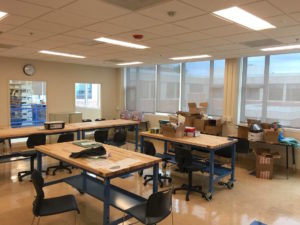Capital City Public Charter School’s makerspace will be the centralized hub of experiential learning, innovation, and 21st century skill building in the school. It will be a joyous, inspiring space, allowing their 659 students in 5th-12th grade to create physical or digital objects that bring concepts to life. The makerspace will set Capital City apart as a place not only to learn, but also as a place for students to gain independence, creativity, and STEAM skills.

Capital City Public Charter School’s progress in early August
Meet the Makers at Capital City Public Charter School
July Update
1. How is your vision for a makerspace innovative?
As an EL (Expeditionary Learning) Education school, Capital City PCS’s focus is on hands-on learning, going out into the world to gain experiences, creating products, and bridging the divide between education and real world application. Our innovative pedagogy is primed for a focus on making, and our makerspace will allow teachers to craft even richer learning experiences. Our makerspace will allow our project-based instructional program to truly blossom, embedding STEAM skills meaningfully into our curriculum.
2. What are you most excited to get started on this summer?
While purchasing and unboxing all of our new technology is exciting, what we are most looking forward to is bringing teachers into the space in August, inviting them to use the materials, and brainstorm effective ways they can use the makerspace with their students!
August Update
3. Can you describe the people who have been involved in your build out?
The library team has been the core team with the build out, including Chip Chase, Brandy Goffigan, and Kishanna Harley. Our facilities team, including Jeff Anderson, Christy Dickens, and Jeff Hayes have supported us in purchasing and assembling furniture and equipment.
4. What has been the most challenging part of the summer build out thus far?
The hardest part of the summer build out has been working virtually with other staff members to create the makerspace. Luckily our plans do not require a large overhaul of the space, just rearranging and acquiring equipment. The bulk of the work in setting up the space will happen in the next few weeks, and we will continue to slowly build out the space over this school year as we work with students and teachers on projects.
5. Have you made adjustments to your original plan since starting your build out? If so, can you describe how you have changed your plan and what sparked the change?
We have made minimal changes to the plan, apart from the possibility of placing furniture in different locations. As we physically realize the space in the next few weeks, we will likely make additional changes as a team.
September Update
6. What advice do you have for other schools developing making programs?
Never be afraid to start small! Putting a simple call out to your school community for old legos, crafting supplies and more can yield a great response to start a collection of crafting materials. Working with students on small projects can lead to a pretty cool proof of concept for a larger makerspace.
Also, Iteration is an important part of the design process. Be ready to fail to meet your initial expectations, and reframe these failures as part of the learning process. Visiting other makerspaces and learning from some of the amazing maker educators who have been doing this work for years is incredibly inspiring. These visits will spark ideas for your own projects and build-outs.
7. As you reflect on your progress, of what are you most proud?
We are most proud of the fact that the space is about 75% complete, with a plan in place to purchase larger items through the rest of the year. A middle school elective makerspace class is being offered this semester, and it’s exciting to see kids in the space. Additionally, it’s been amazing to hear teachers coming to us with all kinds of ideas for making projects.
8. What else do you have in the works for this fall?
This fall we are planning our official launch of the makerspace for our community. We hope that this will include a culminating event for students, faculty and families. In addition to our launch we are planning out a series of orientations to ensure that students and faculty are able to use the tools safely.
October Update
9. How has your makerspace benefitted your school’s CTE program?
We are still building our maker program, but so far, our makerspace has prompted many teachers to rethink some of their projects and deliverables. The excitement about what is possible continues to be built as teachers learn more about the space and see some of the work from our student makers.
10. What was the highlight of your trip to World Maker Faire?
The World Maker Faire was an amazing experience, but one highlight would be having the opportunity to learn about the successful projects and initiatives planned by maker educators across the country. Listening to presentations at the Maker Ed tent and talking to makers about their work was extremely inspiring.
11. Can you tell us about a standout project that is underway or has been completed in your makerspace?
One amazing project came out of a collaboration with Ms. Harley and our art teacher. Students used the makerspace, their creativity, and common objects to create folk art pieces. Twenty-five students’ work was selected to be on display at the Smithsonian Anacostia Community Museum as part of a folk art exhibit!
Learn More About Capital City Public Charter School’s Makerspace
Capital City Public Charter School Makerspace Design (.pptx)
Image of Capital City PCS’s current computer lab, which they are transforming into their makerspace
